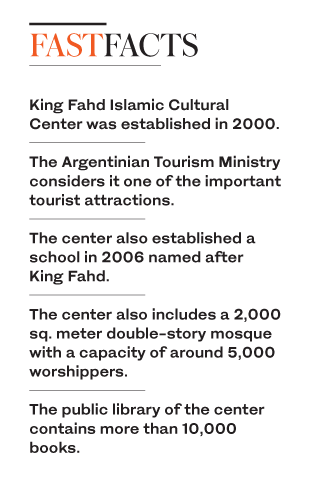JEDDAH: In today’s world, ties between countries are no longer focused on just economic cooperation. Cultural exchange forms a crucial part of a nation’s foreign policies. Saudi Arabia has always been keen to promote mutual understanding with its strategic allies and other friendly nations.
Like other countries of the world, the Kingdom has also established cultural centers across the world to promote a better understanding of the Arab world, its culture and norms and to help other nations understand the region in a mutually beneficial and constructive manner.
The Argentinian capital city, Buenos Aires, is home to one of the biggest cultural centers in the world built by Saudi Arabia. The establishment of King Fahd Islamic Cultural Center in 2000 added a new dimension to the already cordial ties between the two countries.
King Fahd ordered the establishment of the center and it was inaugurated by then-Crown Prince Abdullah.
The center is an architectural marvel which the Argentinian local authorities have included it on the touristic map of the capital city. The Argentinian Tourism Ministry considers it one of the important tourist attractions.
The center not only represents a great Islamic monument but it also illuminates the path for all who are seeking to educate themselves about the Arab Islamic civilization and religion. It helps clarify confusions about the teachings of Islam, which are the result of ignorance and a lack of communication.
The center aims to guide Muslims toward the true path of Islam and to introduce them to the pristine teachings of the noble faith.
The Islamic and cultural center also imparts Qur’an and Arabic language lessons to children. It also provides research sources and books to researchers and students without exception.
The center’s board of trustees, including the Saudi ambassador to Argentina and the director of the center, is presided over by Saudi Arabia’s Islamic Affairs Minister Sheikh Saleh bin Abdul Aziz Al-Asheikh.
The center also established a school in 2006 named after King Fahd. The school has adopted Argentina’s education system with the introduction of two additional courses in Arabic and Islamic culture. More than 6,000 students are enrolled in primary and secondary schools.
The center also includes a 2,000-square-meter double-story mosque with a capacity of around 5,000 worshippers.
The 270-square-meter public library of the center contains more than 10,000 books, including copies of the Qur’an translated into many languages, interpretations of the holy books and some social, scientific and cultural books, manuscripts on the Islamic history, in addition to cultural and historical books about the Kingdom, translated into several languages.
The center also includes a heritage village of 400 square meters showcasing Saudi history along with rare heritage collections, such as clothes, furniture pieces, photos and manuscripts.
The center also has a showroom of 500 square meters that introduces its message, objectives and services along with paintings that depict stories of different prophets and the developmental stages of the Grand Mosque.
A special pavilion is also allocated for the Kingdom’s Vision 2030, translated into several international languages to introduce visitors to the great and continuous efforts exerted by King Salman and Crown Prince Mohammed bin Salman to place the Kingdom among the world’s most developed and advanced countries.
There is a special space of 200 square meters at the center to organize events and receive guests. More than 40,000 visitors and tourists visit the cultural center annually. Over 500 worshippers perform the daily prayers in the mosque and around 1,000 people offer Friday prayers in the biggest mosque in South America.
The center also offers meals during the holy month of Ramadan under the Custodian of the Two Holy Mosques Program. During the last Ramadan, the center provided 6,480 meals and since its establishment, it has provided 120, 650 meals under this program.
The center is also implementing various programs to propagate the true message of Islam.
Providing a helping hand and assistance is considered one of the center’s main objectives, where more than 100 Muslim and non-Muslim families, benefit from the in-kind food aid on a monthly basis.
Recently, Saudi Deputy Minister of Islamic Affairs Tawfiq Abdul Aziz Al-Sudairy inaugurated an exhibition at the cultural center in the presence of Latin American Muslim religious leaders.
The exhibition aims to introduce visitors to the cultural center to Islamic history and civilization, and to the Saudi state’s efforts to serve the Two Holy Mosques and promote communication with different civilizations and cultures.
Saudi Arabia promoting culture of peace and harmony with friendly nations
Saudi Arabia promoting culture of peace and harmony with friendly nations

- The center includes a 2,000-square-meter double-story mosque with a capacity of around 5,000 worshippers
King Abdulaziz Foundation reveals rare images from king’s 1916 Basra visit

- Photographs form part of a wider collection documented by British photographer Gertrude Bell
RIYADH: The King Abdulaziz Foundation has revealed archival photographs documenting King Abdulaziz’s tour of the outskirts of Basra in 1916, a visit that came at an early stage of his efforts to build regional relationships.
One of the photographs, taken by British photographer Gertrude Bell, shows King Abdulaziz standing with his men in the Basra desert, the Saudi Press Agency reported.
The image reflects his early political and diplomatic engagement in the region, as he sought to strengthen ties with neighboring areas and engage with the wider Arab and international community, SPA added.
The photograph forms part of a wider collection documented by Bell, which records key developments and transformations across the Arabian Peninsula during the early 20th century.
The Basra visit holds particular significance in King Abdulaziz’s journey as a unifying leader.
Rather than crossing borders in pursuit of power, the visit reflected an approach focused on stability, cooperation and long-term regional harmony, laying the groundwork for a leadership style defined by pragmatism and openness, SPA said.













